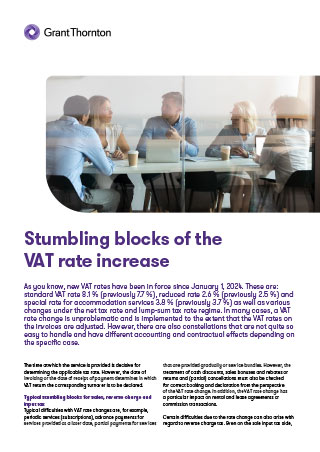-
Audit Financial Services
More security, more trust: Audit services for banks and other financial companies
-
Audit Industry, Services, Institutions
More security, more trust: Audit services for national and international business clients
-
Corporate Tax
National and international tax consulting and planning
-
Individual Tax
Individual Tax
-
Indirect Tax/VAT
Our services in the area of value-added tax
-
Transfer Pricing
Our transfer pricing services.
-
M&A Tax
Advice throughout the transaction and deal cycle
-
Tax Financial Services
Our tax services for financial service providers.
-
Financial Services
Consultancy services that generate real added value for financial service providers.
-
Advisory IT & Digitalisation
Generating security with IT.
-
Forensic Services
Nowadays, the investigation of criminal offences in companies increasingly involves digital data and entire IT systems.
-
Regulatory & Compliance Financial Services
Advisory services in the area of financial market law.
-
Transaction Services / Mergers & Acquisitions
Successfully handling transactions with good advice.
-
Legal Services
Experts in commercial law.
-
Trust Services
We are there for you.
-
Business Risk Services
Sustainable growth for your company.
-
Abacus
Grant Thornton Switzerland Liechtenstein has been an official sales partner of Abacus Business Software since 2020.
-
Accounting Services
We keep accounts for you.
-
Payroll Services
Leave your payroll accounting to us.
-
Real Estate Management
Leave the management of your real estate to us.
-
Apprentices
Career with an apprenticeship?!

The time at which the service is provided is decisive for determining the applicable tax rate. However, the date of invoicing or the date of receipt of payment determines in which VAT return the corresponding turnover is to be declared.
Typical stumbling blocks for sales, reverse charge and input tax
Typical difficulties with VAT rate changes are, for example, periodic services (subscriptions), advance payments for services provided at a later date, partial payments for services that are provided gradually or service bundles. However, the treatment of cash discounts, sales bonuses and rebates or returns and (partial) cancellations must also be checked for correct booking and declaration from the perspective of the VAT rate change. In addition, the VAT rate change has a particular impact on rental and lease agreements or commission transactions.
Certain difficulties due to the rate change can also arise with regard to reverse charge tax. Even on the sole input tax side, the rate change is not always straightforward, for example if the input tax is automatically calculated by accounting software without checking the VAT actually passed on. Apart from this, input tax deduction is only permitted in any case within the scope of business activities in the taxable area and to the extent that this input tax is ultimately paid.
Possible risks and current need for action
With a view to subsequent VAT audits, it is worth checking and ensuring that the VAT rate increase as of January 1, 2024 has been implemented in a VAT-compliant manner in all relevant accounting and contractual aspects. According to administrative practice, the higher VAT rate is generally owed on the entire proceeds if no VAT-compliant differentiation between the previous and new VAT rate has taken place. In addition to the after payment of initially incorrectly paid taxes, interest on arrears is also regularly due, which since January 1, 2024 is now 4.75 % (previously 4.0 %).
It should also be mentioned that a retrospective shift of retrospectively determined higher VAT is usually associated with difficulties. Therefore, the taxable entity should ensure as soon as possible that the VAT rate change has been correctly implemented for its specific business transactions in terms of accounting, contracts and invoices in order to avoid undesirable later cost consequences. This can be done, for example, when preparing the annual financial statements, during which individual transactions can be examined more closely. Corrections to VAT statements for tax years that are not time-barred or have otherwise become legally binding are possible at any time.
Grant Thornton Switzerland/Liechtenstein will be happy to advise your company on questions regarding the VAT-compliant implementation of the VAT rate change. We look forward to hearing from you.


